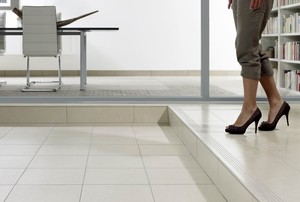Silence tiles
 In order to minimise the dimensional requirements for the composition of impact sound insulation, we offer a very effective solution using an SDI sound insulation panel. During laying, the slab is placed right under the ceramic tiles, with the resulting composition providing the defined sound transmission attenuation.
In order to minimise the dimensional requirements for the composition of impact sound insulation, we offer a very effective solution using an SDI sound insulation panel. During laying, the slab is placed right under the ceramic tiles, with the resulting composition providing the defined sound transmission attenuation.
Moreover, the panel eliminates the risk of shear stress under excessive deformations in the floor structure, thus allowing the laying of tiles on entirely non-standard bases (such as wooden ceiling structures, particleboard flooring, etc.).
Type of structure
- For concrete substrates: PE 202 penetration coating, LE 30 self-levelling screed
- For flexible (wooden) substrates: chipboard in two layers, LE 30 self-levelling material (osb boards in two layers, with CP 203 contact bridge placed onto them)
- DSAT self adhesive joint tape
- AD 590 or AD 530 adhesive
- SDI slab
- AD 590 or AD 530 adhesive
- ceramic tiles
- GF DRY or GFS flexible jointing material
- SI silicone sealant + PES polyethylene separator
Work procedure – detailed description
Preparation: The base (concrete, anhydrite) must exhibit adequate strength and consistency before laying. The base flatness deviation must not exceed 2 mm per 2 m of the bar. In the event of any shortcomings identified in this area, use LE 20 or LE 30 self-levelling material. When the laying is undertaken onto a wooden grate, the base should be strengthened with the installation of two OSB board layers. The 18 mm- and 15 mm-thick boards are laid on the joint connections, perfectly fixing the two layers to one another with screws.
Base priming: The absorbent flooring structure surfaces (concrete, anhydrite) must be primed with PE 202 at the required dilution ratio (approx. 1:3-5). Approximately 0.15 l/m2 of liquid is needed. A contact bridge must be applied to deformable and non-absorbent bases (Cetris, OSB) using the CP 203 filler-bearing product. Approx. 0.25-0.4 kg/m2 is needed for the contact bridge.
Installation of a peripheral insulation strip: A self-adhesive DSAT separating strip, 25 mm wide, must be installed around the circumference of the insulated surface. The strip will disrupt any sound bridges formed between the tiles/wall.
Installation of a separation panel: The SDI panel is installed using C2FTE S1 grade AD 590 cement adhesive, which, with its special composition, ensures perfect contact with the panel material and shortens the application intervals. We use a Swedish smoother, 3-4 mm long, which gives a consumption figure of approx. 2.1 kg/m2. We recommend that the joints between the boards be resealed with a narrow paper tape preventing any sound bridges from developing when the tiles are attached.
Insulation – sealing all water-loaded spots: The insulation is applied to the integrated SDI panels, see bathroom system solutions.
Installation of ceramic tiles: Again, C2FTE S1 grade AD 590 cement adhesive is used for installation of the ceramic tiles. An 8 mm smoother is used and approx. 4.2 kg/m2 is needed for attaching the tiles.
Jointing the tile surface: Once the adhesive has fully cured, CG2 WA grade GD DRY cement adhesive (available in the full colour spectrum of 24 colours) is used for full-area jointing. Where used on massively deforming bases, we recommend using the quick drying CG2 WA S1 grade GFS product, with increased transversal deformation properties. Approx. 0.4-0.8 kg/m2 is needed.
Sealing of expansion joints: In the peripheral joint at the base interface, and in expansion joints, it becomes necessary to use the permanently elastic SI silicone sealant, which is supplied in the colour range of the GF DRY material. If SI silicone is applied, it is recommended that a PES polyethylene separator be used. It will prevent undesired adhesion to the bottom of the joint and define the exact shape of the silicone. The spreading rate of the 310 ml cartridge is approx. 6-12 bm, depending on the size of the joint.
Cleaning: Once the cement residue is removed, use the CL 802 cleaning agent. Once the surface is thoroughly cleaned, we recommend that full-surface priming be applied with CL 809.
Maintenance: For regular maintenance, use the CL 803 cleaning agent combined with CL 802 (scale) and CL 810 (grease).







